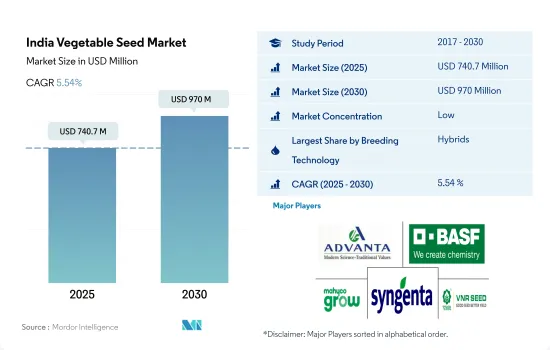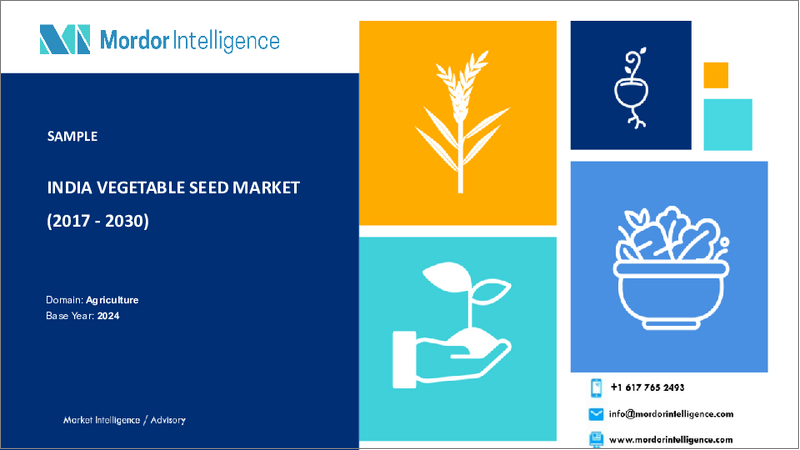|
|
市場調査レポート
商品コード
1693489
インドの野菜種子:市場シェア分析、産業動向、成長予測(2025~2030年)India Vegetable Seed - Market Share Analysis, Industry Trends & Statistics, Growth Forecasts (2025 - 2030) |
||||||
カスタマイズ可能
適宜更新あり
|
|||||||
| インドの野菜種子:市場シェア分析、産業動向、成長予測(2025~2030年) |
|
出版日: 2025年03月18日
発行: Mordor Intelligence
ページ情報: 英文 362 Pages
納期: 2~3営業日
|
全表示
- 概要
- 目次
概要
インドの野菜種子市場規模は2025年に7億4,070万米ドルと予測され、2030年には9億7,000万米ドルに達し、予測期間(2025~2030年)のCAGRは5.54%で成長すると予測されています。

高収量・耐病性特性によりハイブリッド種子がインドの野菜種子市場を独占
- インドは中国に次いで世界第2位の野菜生産国です。インドにおける野菜の生産量と平均生産性は、近代的農法の非適応性と低収量品種の使用により、他国よりはるかに遅れています。
- 2022年の野菜種子市場では、野菜生産におけるハイブリッド種の使用増加により、ハイブリッド種が79.4%、開放受粉品種とハイブリッド派生品種が20.6%を占めます。
- OPV種子は、タピオカ、ヤムイモ、サツマイモのような根菜類や球根類とともに葉菜類に多く、農業従事者が副収入を得るために耕地の一部で毎年生産することを望んでいるためです。このような状況下で、小規模農業従事者はOPV種子を次の作物用に保存しています。
- トマト、ブリンジャール、オクラ、チリ、ウリ科の野菜は、ハイブリッド種子を用いて栽培される主要な野菜であり、トマトとブリンジャールでは品種開発が盛んで、インドでは主に公的部門からハイブリッドとOPVが発表されています。インドでは、農業従事者が低価格、味、形、大きさの点からOPVを好むため、予測期間中にハイブリッド種子は5.5%、OPVは5.7%のCAGRで推移すると予測されます。
- インドでは人口が増加し、耕地面積が減少しているため、ハイブリッドやOPVの高収量品種に対する需要が高まっている
- しかし、遺伝子組換え野菜の研究検査が進行中であり、近い将来、遺伝子組換えブリンジャールが発表されることが期待されています。安全で高収量の品種に関する政府の施策も、インドのハイブリッドの野菜種子市場の成長を後押しすると予想されます。
インドの野菜種子市場動向
根菜類と球根類が野菜作物の栽培面積の大半を占め、これらの作物に対する需要が高く、輸出の可能性が高いです。
- インドにおける野菜の栽培面積は連作作物よりも低いです。2022年の耕作面積は6.0%でした。野菜の栽培面積は2017~2022年の間に6.6%増加しました。これは主に、保護された栽培構造による野菜栽培の増加と、健康的で菜食主義的な食生活に対する需要の増加によるものです。
- 野菜の栽培面積では、根菜類と球根類が最大のシェアを占めています。同国はタマネギとジャガイモの主要生産国のひとつであるため、2022年の同セグメントのシェアは46%でした。同国の消費者は調味料としてタマネギを好み、輸出ポテンシャルも高いです。ジャガイモはアルー・ティッキ、パランタなどのインド料理に使用されるため、タマネギとジャガイモの栽培面積が多いです。例えば、インドのタマネギ栽培面積は2017年の130万ヘクタールから2022年には160万ヘクタールに増加しています。
- ナス科作物の栽培面積は2022年には237万ヘクタールとなり、トマトが主要な栽培面積を占めました。インドにおけるトマトの栽培面積は、2017年の797,000haから2022年には857,321.1haに増加しました。栽培面積の増加はトマト種子の需要を増加させると推定されます。レタス、ホウレンソウ、その他の緑葉野菜などのその他の分類外野菜は、栄養価が高いため需要が増加していること、サラダの消費が伸びていることから、2017~2022年にかけて栽培面積が6.2%増加(130万ヘクタール)しています。同国は野菜の主要生産国であり、野菜に対する需要が高まっていることから、予測期間中に栽培面積が増加すると見込まれます。
様々な病害に対する感受性と高品質の農作物への需要が、病害に対する耐性、幅広い適応性、品質特性を持つキャベツとタマネギ品種の利用を促進しています。
- キャベツは国内で広く栽培されています。高付加価値製品に対する需要は、国内市場でも国際市場でも高まっています。国内で入手可能な人気の高い形質は、頭重、葉色、幅広い季節への適応性(キャベツは寒さに特有であるため)、早熟性、葉面病に対する耐病性です。頭の大きさと頭重は、1ヘクタールあたりの収量生産性を高めるのに役立つため、大きな需要がある主要形質です。シンジェンタAGやBayerAGなどの企業は、悪天候下でも高品質で栽培できるよう、これらの形質を持つ種子を提供しています。
- タマネギは、インドで栽培されている主要な野菜作物のひとつです。世界的に、インドのタマネギは辛味で有名です。耐病性、貯蔵期間の長さ(長期貯蔵や長距離輸送時の腐敗ロスの回避に役立つ)、大きさの均一性、タマネギの色(赤、黄、白)、害虫(特にアザミウマ)に対する耐性、早生品種などの主要形質が、国内でのタマネギ栽培を促進しています。Bayer AG、BASF SE、Bejo Zaden BVといった大手種苗会社は、高収量、魅力的な色、冬期適応性に重点を置いた品種を開発しています。紫斑病やべと病に対する耐病性を持つ品種は、収量が20%~60%低下するため、広く栽培されています。例えば、2021年にBejoとDe Groot en Slotは、イノベーターと名付けられた種子から初のダウニー抵抗性エシャロットを発売しました。
- 高い耐病性を持つ高品質の作物、保存期間の延長、品質属性形質を持つ製品イノベーションが、予測期間中にこれらの種子の需要を増加させるのに役立っています。
インドの野菜種子産業概要
インドの野菜種子市場は細分化されており、上位5社で28.06%を占めています。この市場の主要企業は、Advanta Seeds-UPL、BASF SE、Maharashtra Hybrid Seeds Co.(Mahyco)、Syngenta Group、VNR Seedsなどです。
その他の特典
- エクセル形式の市場予測(ME)シート
- 3ヶ月のアナリストサポート
目次
第1章 エグゼクティブサマリーと主要調査結果
第2章 レポートのオファー
第3章 イントロダクション
- 調査の前提条件と市場定義
- 調査範囲
- 調査手法
第4章 主要産業動向
- 栽培面積
- 野菜
- 最も人気のある形質
- キャベツ&タマネギ
- トマトと唐辛子
- 育種技術
- 野菜
- 規制の枠組み
- バリューチェーンと流通チャネル分析
第5章 市場セグメンテーション
- 育種技術
- 雑種
- 開放受粉品種とハイブリッド派生品種
- 栽培メカニズム
- 露地栽培
- 保護栽培
- 作物ファミリー
- アブラナ科
- キャベツ
- ニンジン
- カリフラワー&ブロッコリー
- その他のアブラナ
- ウリ科
- キュウリ・ガーキン
- かぼちゃ・カボチャ
- その他ウリ科
- 根菜・球根
- ニンニク
- タマネギ
- ジャガイモ
- その他の根菜類
- ナス科
- 唐辛子
- ナス科
- トマト
- その他ナス科
- 分類されていない野菜
- アスパラガス
- レタス
- オクラ
- エンドウ豆
- ほうれん草
- その他分類されていない野菜
- アブラナ科
- 州
- ビハール州
- チャティスガル州
- グジャラート州
- Haryana
- マディヤ・プラデシュ州
- マハラシュトラ州
- オディシャ
- タミルナドゥ州
- ウッタル・プラデシュ州
- 西ベンガル州
- その他の州
第6章 競合情勢
- 主要な戦略動向
- 市場シェア分析
- 企業情勢
- 企業プロファイル
- Advanta Seeds-UPL
- BASF SE
- Bayer AG
- East-West Seed
- Groupe Limagrain
- Maharashtra Hybrid Seeds Co.(Mahyco)
- Rijk Zwaan Zaadteelt en Zaadhandel BV
- Sakata Seeds Corporation
- Syngenta Group
- VNR Seeds
第7章 CEOへの主要戦略的質問
第8章 付録
- 世界概要
- 概要
- ファイブフォース分析フレームワーク
- 世界のバリューチェーン分析
- 世界市場規模とDRO
- 情報源と参考文献
- 図表リスト
- 主要な洞察
- データパック
- 用語集
目次
Product Code: 92552
The India Vegetable Seed Market size is estimated at 740.7 million USD in 2025, and is expected to reach 970 million USD by 2030, growing at a CAGR of 5.54% during the forecast period (2025-2030).

Hybrids dominated the Indian vegetable seed market due to their high-yielding and disease-resistant traits
- India is the second-largest vegetable producer in the world after China. The production and average productivity of vegetables in India are far behind other countries due to the non-adaptability of modern agricultural practices and the use of low-yielding varieties.
- In 2022, hybrids and open-pollinated varieties & hybrid derivatives accounted for 79.4% and 20.6%, respectively, of the vegetable seed market due to an increase in the usage of hybrids in vegetable production.
- OPV seeds are more common in leafy vegetables, along with some roots and bulbs such as tapioca, yams, and sweet potato, as farmers are willing to produce them every year on some portion of the arable land for extra income. In this context, small-scale farmers use OPV seeds to save them for the next crop.
- Tomato, brinjal, okra, chili, and cucurbits are the major vegetables grown using hybrid seeds, and the varietal development in tomato and brinjal is high, with hybrid and OPVs being released from the public sector mostly in India. In India, hybrid and OPVs are estimated to register CAGRs of 5.5% and 5.7%, respectively, during the forecast period, as farmers prefer OPVs for their low price, taste, shape, and size.
- The increasing population and decreasing arable land in India are boosting the demand for high-yielding varieties of hybrids or OPVs, along with disease and pest resistance, to decrease the input costs, as 80% of Indian farmers are small and marginal farmers.
- However, with the ongoing research trials in genetically modified vegetables, GM brinjal is expected to be released in the near future. Government policies on safe and high-yielding varieties are also expected to boost the growth of the hybrid vegetable seed market in India.
India Vegetable Seed Market Trends
Roots and bulbs dominated the area under cultivation of vegetable crop with higher demand for these crops and high export potential
- The area under cultivation for vegetables in India is lower than that of row crops. In 2022, it was 6.0% of the area cultivated in the country. The area under vegetable cultivation increased by 6.6% between 2017 and 2022. This is mainly due to the increased cultivation of vegetables through protected cultivation structures and increased demand for a healthy and vegan diet.
- Roots and bulbs had the largest share in the area under cultivation of vegetables. The segment had a share of 46% in 2022 as the country is one of the major producers of onion and potato. Consumers in the country prefer onions for seasoning, and they have high export potential. Potatoes are used in Indian cuisines such as aloo tikki, paranthas, and others, which led to high areas under onion and potato cultivation. For instance, India's area under onion cultivation increased from 1.3 million hectares in 2017 to 1.6 million hectares in 2022.
- The area under Solanaceae crop cultivation was 2.37 million hectares in 2022, and tomatoes accounted for the major area under cultivation. The area under tomato cultivation in India increased from 797,000 ha in 2017 to 857,321.1 ha in 2022. The increased cultivation area is estimated to increase the demand for tomato seeds. Other unclassified vegetables such as lettuce, spinach, and other green leafy vegetables have witnessed a growth of 6.2% in the area cultivated from 2017 to 2022 (1.3 million hectares) due to an increase in the demand for these vegetables as they have high nutritional value and growth in the consumption of salads. The rising demand for ve getables, with the country being a major producer of vegetables, is estimated to increase the area under cultivation during the forecast period.
Susceptibility to various diseases and demands for high-quality crop produce are driving the usage of cabbage and onion varieties with resistance to diseases, wider adaptability, and quality attributes
- Cabbage is widely cultivated in the country. The demand for high-value products is growing both in domestic and international markets. Popular traits available in the country are head weight, foliage color, adaptability to wide seasons (as cabbage is cold-specific), early maturity, and disease tolerance to foliar diseases. The size of heads and head weight are the major traits that have a significant demand, as they help increase yield productivity per hectare. Companies such as Syngenta AG and Bayer AG provide seeds with these traits to grow with high quality in adverse weather conditions.
- Onion is one of the major vegetable crops cultivated in the country. Globally, Indian onions are famous for pungency. Major traits such as disease tolerance, long shelf-life (helps in avoiding decay losses during long storage and long-distance transports), uniform size, the color of the onions (red, yellow, and white), tolerance to pest attacks, especially thrips, and early maturing varieties are promoting onion cultivation in the country. The major seed companies, such as Bayer AG, BASF SE, and Bejo Zaden BV, are developing varieties focusing on high yields, attractive colors, and winter adaptability traits. Varieties with disease resistance to purple blotch and downy mildew are widely cultivated, as they cause yield loss of 20%-60%. For instance, in 2021, Bejo and De Groot en Slot launched the first Downy-resistant shallot from seed named Innovator.
- High-quality crops with high disease resistance, increased shelf life, and product innovations with quality attribute traits are helping to increase the demand for these seeds during the forecast period.
India Vegetable Seed Industry Overview
The India Vegetable Seed Market is fragmented, with the top five companies occupying 28.06%. The major players in this market are Advanta Seeds - UPL, BASF SE, Maharashtra Hybrid Seeds Co. (Mahyco), Syngenta Group and VNR Seeds (sorted alphabetically).
Additional Benefits:
- The market estimate (ME) sheet in Excel format
- 3 months of analyst support
TABLE OF CONTENTS
1 EXECUTIVE SUMMARY & KEY FINDINGS
2 REPORT OFFERS
3 INTRODUCTION
- 3.1 Study Assumptions & Market Definition
- 3.2 Scope of the Study
- 3.3 Research Methodology
4 KEY INDUSTRY TRENDS
- 4.1 Area Under Cultivation
- 4.1.1 Vegetables
- 4.2 Most Popular Traits
- 4.2.1 Cabbage & Onion
- 4.2.2 Tomato & Chilli
- 4.3 Breeding Techniques
- 4.3.1 Vegetables
- 4.4 Regulatory Framework
- 4.5 Value Chain & Distribution Channel Analysis
5 MARKET SEGMENTATION (includes market size in Value in USD, Forecasts up to 2030 and analysis of growth prospects)
- 5.1 Breeding Technology
- 5.1.1 Hybrids
- 5.1.2 Open Pollinated Varieties & Hybrid Derivatives
- 5.2 Cultivation Mechanism
- 5.2.1 Open Field
- 5.2.2 Protected Cultivation
- 5.3 Crop Family
- 5.3.1 Brassicas
- 5.3.1.1 Cabbage
- 5.3.1.2 Carrot
- 5.3.1.3 Cauliflower & Broccoli
- 5.3.1.4 Other Brassicas
- 5.3.2 Cucurbits
- 5.3.2.1 Cucumber & Gherkin
- 5.3.2.2 Pumpkin & Squash
- 5.3.2.3 Other Cucurbits
- 5.3.3 Roots & Bulbs
- 5.3.3.1 Garlic
- 5.3.3.2 Onion
- 5.3.3.3 Potato
- 5.3.3.4 Other Roots & Bulbs
- 5.3.4 Solanaceae
- 5.3.4.1 Chilli
- 5.3.4.2 Eggplant
- 5.3.4.3 Tomato
- 5.3.4.4 Other Solanaceae
- 5.3.5 Unclassified Vegetables
- 5.3.5.1 Asparagus
- 5.3.5.2 Lettuce
- 5.3.5.3 Okra
- 5.3.5.4 Peas
- 5.3.5.5 Spinach
- 5.3.5.6 Other Unclassified Vegetables
- 5.3.1 Brassicas
- 5.4 State
- 5.4.1 Bihar
- 5.4.2 Chhattisgarh
- 5.4.3 Gujarat
- 5.4.4 Haryana
- 5.4.5 Madhya Pradesh
- 5.4.6 Maharashtra
- 5.4.7 Odisha
- 5.4.8 Tamil Nadu
- 5.4.9 Uttar Pradesh
- 5.4.10 West Bengal
- 5.4.11 Other States
6 COMPETITIVE LANDSCAPE
- 6.1 Key Strategic Moves
- 6.2 Market Share Analysis
- 6.3 Company Landscape
- 6.4 Company Profiles
- 6.4.1 Advanta Seeds - UPL
- 6.4.2 BASF SE
- 6.4.3 Bayer AG
- 6.4.4 East-West Seed
- 6.4.5 Groupe Limagrain
- 6.4.6 Maharashtra Hybrid Seeds Co. (Mahyco)
- 6.4.7 Rijk Zwaan Zaadteelt en Zaadhandel BV
- 6.4.8 Sakata Seeds Corporation
- 6.4.9 Syngenta Group
- 6.4.10 VNR Seeds
7 KEY STRATEGIC QUESTIONS FOR SEEDS CEOS
8 APPENDIX
- 8.1 Global Overview
- 8.1.1 Overview
- 8.1.2 Porter's Five Forces Framework
- 8.1.3 Global Value Chain Analysis
- 8.1.4 Global Market Size and DROs
- 8.2 Sources & References
- 8.3 List of Tables & Figures
- 8.4 Primary Insights
- 8.5 Data Pack
- 8.6 Glossary of Terms






